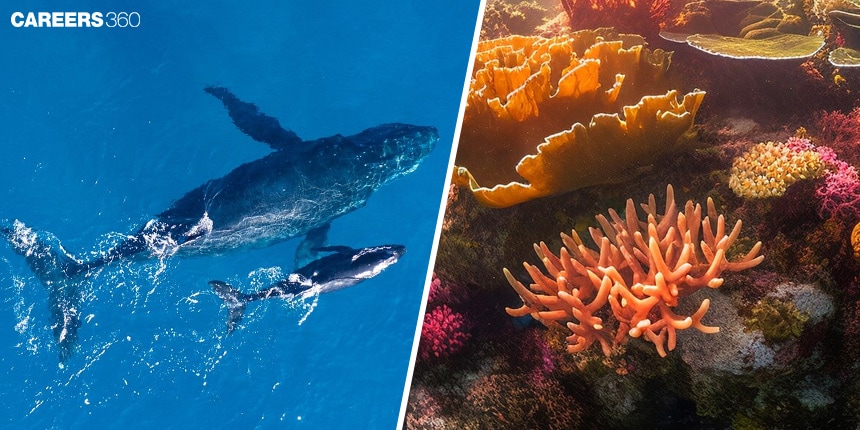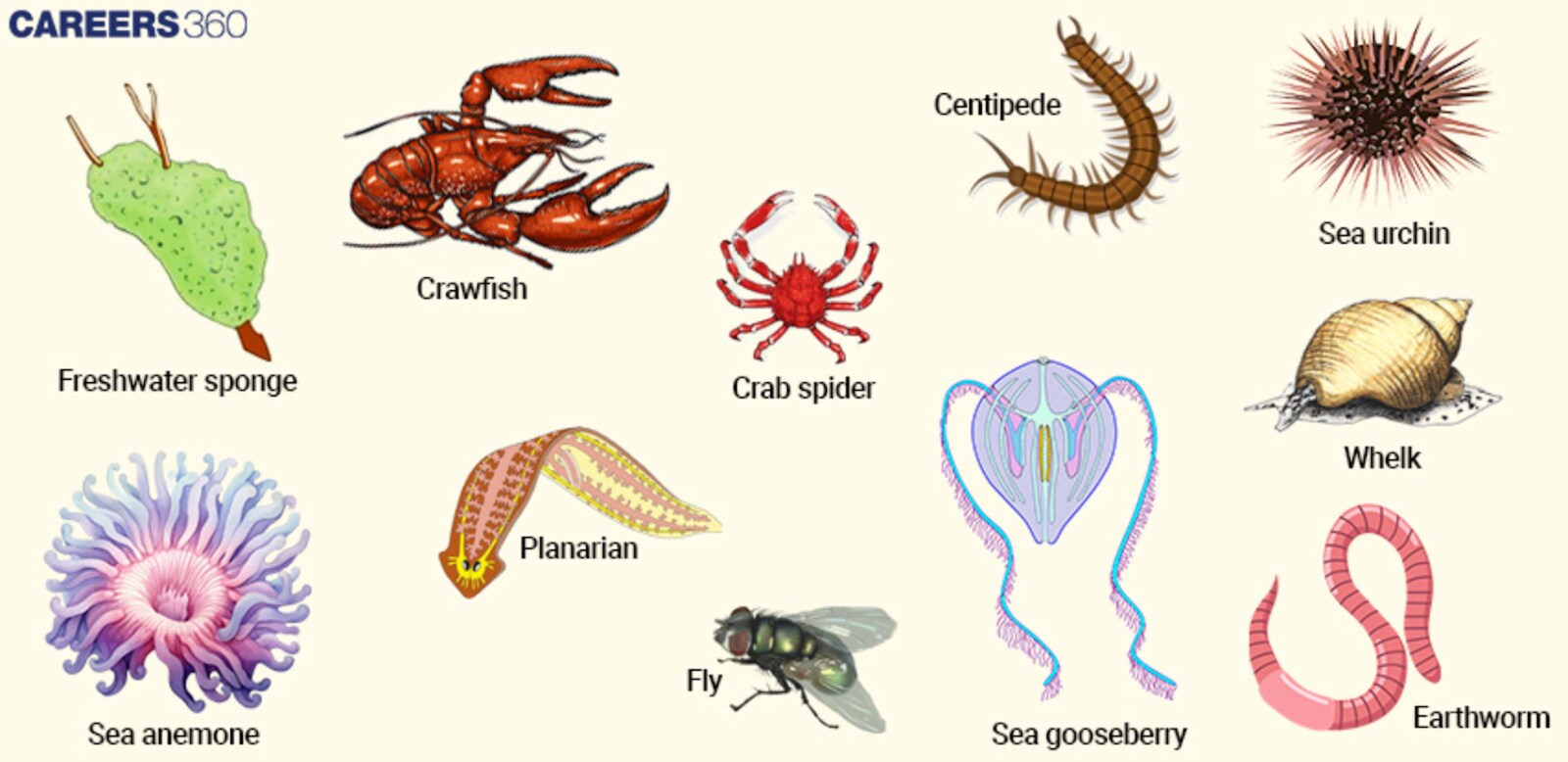Difference Between Chordates and Non-chordates: Chordates v/s Non Chordates
What Are Chordates?
Chordates are animals which possess a notochordal or hollow nerve tube, notochord, pharyngeal slits and a tail which is post--anal during some period of embryonic development. There is the formation of a nerve cord which in the case of vertebrates is known as spinal; it creates a central nervous system. The notochord is also involved in support and is replaced in vertebrates by the vertebral column. Other functions of pharyngeal slits include feeding and gas exchange whereas the post-anal tail provides motion and stabilisation of the organism.
Latest: NEET 2024 Paper Analysis and Answer Key
Don't Miss: Most scoring concepts for NEET | NEET papers with solutions
New: NEET Syllabus 2025 for Physics, Chemistry, Biology
NEET Important PYQ & Solutions: Physics | Chemistry | Biology | NEET PYQ's (2015-24)

Chordates comprise the fishes, amphibians, reptiles, birds, mammals, and those organisms not having backbones, namely the tunicates and the lancelets. It is in the subphylum Vertebrata where animals have the backbone and such adaptations as gills in fish, extra wings in owls, etc.
Table comparing major groups
Group | Characteristics |
Fishes | Gills, scales, fins, lay eggs in water. |
Amphibians | Moist skin, metamorphosis, typically aquatic larvae. |
Reptiles | Scales, lungs, and amniotic eggs are laid on land. |
Birds | Feathers, wings for flight, lay hard-shelled eggs. |
Mammals | Hair/fur, and mammary glands, mostly give birth to live young. |
What Are Non-Chordates?
Non-chordates are a very large and diverse category of animals that never at any time in their life possess one or other of the chordate characteristics notochord, dorsal hollow nerve cord pharyngeal slits, part or all of a post-anal tail. However, they do present a rather diverse morphological plasticity in the type and organisation of body plans as well as physiological abilities. Non-chordates are many and diverse including Porifera, Cnidaria, Platyhelminthes, Annelida, Mollusca, and Arthropoda among others.
Broad Classification Into Various Phyla
Porifera (Sponges): Algae is a simple organism that has a permeable body that feeds with the help of water currents that help filter water.
Cnidaria: List why jellyfish, corals and sea anemones belong to the group of cnidarians The answer consists of stinging cells called cnidocytes.
Platyhelminthes: First, non-coelomate Bilateral which consists of a flatworm with or without a notochord, that is endoparasitic, such as the tapeworm.
Annelida: Earthworm and leech with a body cavity or coelom but are segmented worms.
Mollusca: Animals that do not have a rigid body but have a stiff part of the body like shells; includes; snails, clams, squids.
Arthropoda: It contains the greatest number of species; insects, spiders, crustaceans, that generally have joint appendages, and an external covering known as the exoskeleton.
Examples
Sponges (Phylum Porifera): They are the earliest and the simplest form of filter feeders that have a porous body structure.
Jellyfish (Phylum Cnidaria): Coelenterates with ä Appendages bearing cnidocytes such as nematocysts.
Flatworms (Phylum Platyhelminthes): Organisms which are soft-bodied and have bilateral symmetry such as those belonging to the phylum Platyhelminthes but not the echinoderms; parasitic organisms like; tapeworms.
Insects (Phylum Arthropoda): Multitudes of well-coordinated members with entrenched segmented, hard outside covering and articulated extremities.
Crustaceans (Phylum Arthropoda): Legged sea and freshwater crustaceans with segmented external coats such as crabs and other kinds of lobsters.
Diagram illustrating diversity among non-chordates.

Structural Differences Between Chordates And Non-Chordates
Structural differences are listed below-
Body Organization
Chordates: In adults, it may show bilateral symmetry.
Non-chordates: Some of them have radial symmetry like cnidarians or asymmetrical bodies like sponges.
Chordates: Frequently possess division (i. e annelids, vertebrates).
Non-chordates: Do not possess real differentiation or have a very low level of differentiation (ee. g. flatworms).
Presence Of Chordate Characteristics
Dorsal Hollow Nerve Cord (Nervous System):
Chordates: Have a dorsal hollow nerve cord which invertebrates give rise to the spinal cord in vertebrates.
Non-chordates: Do not possess a well-developed nerve cord; nervous arrangements are different (for instance, nerve plexi in cnidarians, a diffuse plan in flatworms).
Notochord (Support):
Chordates: Create a notochord, a grandiose, elongated structure used as an embryonic spine.
Non-chordates: Lack a notochord; other support systems are the hydrostatic skeletons as seen in roundworms or the exoskeleton as seen in arthropods.
Pharyngeal Slits (Respiration and Feeding):
Chordates: Possess pharyngeal slits which are used possibly in filter feeding, breathing or in the developmental stage.
Non-chordates: Lack of pharyngeal slits; feeding structures diverse (e.g., true renters in molluscs, mouth hooks and palpi in insects).
Nervous System And Sensory Organs
The nervous system is described below-
Nervous System
Contrast in nervous system complexity:
Chordates: Chordates have a tubular system of neurones of which a dorsal hollow nerve cord is the centre of the developing spinal cord in vertebrates. This nerve cord provides a favourable pathway for conducting the sense organ impulses and the motor reactions.
Non-chordates: In most Non-chordates, there is a Nowell-developed centralized nerve cord. Instead, they can have a nerve net or diffuse nerve network – an organization of the nerves much simpler, which serves mainly for immediate reactions to stimuli. For example, cnidarians which are jellyfish have what is termed a nerve net that helps in the coordination of body movements as well as the responses to touch among other stimuli.
Sensory Organs
Comparison of sensory structures:
Eyes:
Chordates: While in protochordate, the organs of vision are simple, cords, lenses and retinae are absent but in fully developed chordates the structures involved in vision attain further differentiation with lenses and retinae that can form the image. Almost all the members of this class have normal body vision, which includes color vision and lens depth depending on the habitat of the organism.
Non-chordates: A few photoreceptors known as ocelli in the body of non-chordates are sometimes as good as receptors which are only in the form of light but cannot distinguish between one image the another. For instance, a structure known as eyespots in flatworms helps to detect the amount of light in the direction.
Antennae:
Chordates: The antennae are however lacking in Chordata even though the larvae of this subphylum, or the most primitive forms of it, may possess antennae.
Non-chordates: Other invertebrates which are non-chordates possess antennae in the form of organs of touch, smell or taste are some other examples.
Statocysts:
Chordates: They are scarce in chordates predominantly.
Non-chordates: This sub-group of the phylum without a backbone is provided with a statocyst which is a fluid-filled chamber of statoliths or grains of calcium carbonate used to sense orientation to gravity.
Circulatory System And Respiration
The circulatory system is described below-
Circulatory System
Chordates: In chordates, blood flow is closed and blood is transported through vessels such as arteries, veins and capillaries for transport of gases, nutrients and wastes. The animals in the subphylum Vertebrata possess a chambered heart with atria and ventricles which efficiently pump the blood.
Non-chordates: The circulation in many non-chordates may be an open one in which blood exists within a hemocoel or body cavity and flows directly over the organs. Some of the animals, particularly insects and some mollusk-like animals have a tubular heart that pumps the hemolymph which is a kind of blood into the hemocoel to directly interact with the tissues.
Evolutionary Advantage In Chordates
Chordates, mainly the vertebrates have a closed circulatory system hence a well-developed heart. The heart’s chambers help to facilitate the division of oxygenated and deoxygenated blood making oxygen delivery to tissues improve metabolism.
Respiration
Variations in respiratory structures
Chordates and non-chordates exhibit diverse respiratory adaptations suited to their habitats:
Gills: Located in fishes and certain other animals such as molluscs and crustaceans gills are specialized organs of respiration in water.
Lungs: buried in the body of almost every tetrapod or terrestrial vertebrate, which includes amphibians, reptiles, birds and mammals, lungs are specific vital organs that take charge of the exchange of gases between the atmosphere and the blood.
Tracheal system: Some insects and certain other arthropods possess tracheal tubes that carry air directly to the tissues increasing the effectiveness of respiratory apparatus in terrestrial conditions.
Comparative table showing respiratory adaptations.
Group | Respiratory Structures |
Fish (Chordates) | Gills for underwater respiration, counter-current flow system for efficient oxygen extraction. |
Amphibians (Chordates) | Gills in larvae, lungs and skin for adults; buccal pumping for ventilation. |
Reptiles (Chordates) | Lungs for respiration; some species have modified structures (e.g., crocodilians have hepatic-piston lungs). |
Birds (Chordates) | Lungs supplemented by air sacs for efficient unidirectional airflow; high metabolic demands for flight. |
Mammals (Chordates) | Lungs with alveoli for efficient gas exchange; diaphragm aids in breathing. |
Insects (Non-chordates) | A tracheal system with air-filled tubes extending throughout the body; spiracles for gas exchange. |
Molluscs (Non-chordates) | Gills in aquatic species (e.g., bivalves, gastropods); mantle cavity aids in gas exchange. |
Reproduction And Life Cycle
The reproduction and life cycle are listed below-
Reproductive Strategies
Contrast in reproductive strategies:
Chordates: Fertilization is found both in the external and internal types among chordates. Internal fertilization is typical for the majority of the terrestrial and some of the aqueous animals; reproductive organs are involved here.
Non-chordates: Many non-chordates employ external fertilization whereby the eggs and sperm are released to the surroundings and get fertilized. This strategy is widespread in water habitats, particularly in numerous offspring-producing species.
Developmental Stages
Embryonic development:
Chordates: Chordates’ embryonic development entails characteristic features such as a notochord at some point. Notochord is used as a supporting structure and a developmental signpost and is later replaced by the vertebral column in the case of vertebrates.
Non-chordates: Some of the substrate characteristics that separate the non-chordates from the chordates are that they do not undergo the development of notochord at any one time in their life. However, they may pass through different life forms like the larvae that are found in insects like caterpillars that transform into butterflies and tadpoles into frogs of the insects.
Frequently Asked Questions (FAQs)
The chordates are sub-grouped based on the following features: the presence of a dorsal hollow nerve cord, a notochord or vertebral column, pharyngeal slits or pouches and a postanal tail at some stage of their development.
Chordates may have bilateral body plans and may or may not have segmentation while non-chordates in general may have radial or asymmetrical body plans and are non-segmented.
Some of the non-chordates examples of phyla that are included are Porifera, Cnidaria, Platyhelminthes, Annelida, Mollusca, and Arthropoda among others.
For this reason, chordates are seen as being of higher development than non-chordates, especially because of the presence of a centralised nerve cord, sophisticated sensory organs such as eyes and ears in many of the chordates and a greater level of behavioural efficiency as well as adaptability.
While external fertilisation is seen occasionally in chordates, internal fertilisation is faired more among the terrestrial ones. This is external fertilisation, this is because the majority of non-chordates lay their eggs in water hence fertilisation takes place in water.
Also Read
04 Nov'24 10:07 AM
04 Nov'24 09:35 AM
23 Oct'24 04:28 PM
22 Oct'24 06:06 PM
22 Oct'24 08:21 AM
15 Oct'24 11:41 PM
14 Oct'24 07:02 PM
04 Oct'24 09:47 AM
03 Oct'24 06:36 PM